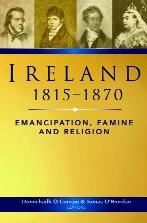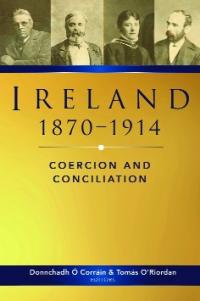MultiText: Irish history on-line
Published in 20th-century / Contemporary History, Issue 3 (May/June 2011), News, Volume 19
The first book in the History of Ireland series, based on MultiText’s essays, Ireland 1815–70: emancipation, famine and religion, was published earlier this year. The second, Ireland 1870–1914: coercion and conciliation, will be in the shops shortly.
Dramatic changes in information technology, particularly in multimedia and social networking, in recent years have opened up new vistas in the presentation of research and in teaching and student enquiry. The MultiText Project in History is unique in terms of its value to Irish history teachers and students. Its essays are written by leading scholars, working closely with teachers and academics in research-related areas, in Ireland and abroad. The authoritative tone, allied with the guaranteed integrity and provenance of the material, is particularly important, since random internet searches will not always lead students to reliable sources. The website, which receives over 20,000 hits per day, contains over a million words of searchable text (essays, primary documents, tables etc.) and an image archive containing over 4,000 photographs, cartoons, maps and drawings. These free resources meet the specific requirements of the revised Leaving Certificate curriculum (first examined in June 2006), and go beyond it. Instead of the traditional concentration on political history, the website introduces students to a great diversity of perspectives in considering the past: social, economic, cultural and religious. It trains students to apply the skills and methodologies used by professional historians through the use of primary sources. It is hoped that the teaching materials will encourage many educators to consider teaching a wider range of topics.
Digital technology has revolutionised history-in-the-making, as well as the analysis and distribution of recordings of events. The mostly black-and-white photos featured on MultiText are arresting portraits and scenes in the categories of science, technology, religion, daily life, politics, the arts and sports. They remind us of the importance of photography, not just in capturing memories and cataloguing history (propaganda and all) as it happens but also in its ability to influence the future. Some images can be powerful enough to make us change how we live. Emerging research findings indicate that the employment of a ‘pedagogical-visual-digital’ approach assists learners to draw ‘historical meaning . . . from new, relatively unfamiliar types of sources when presented to a public increasingly accustomed to visual communication’. MultiText has established excellent relations with the principal national institutions of learning and has been given access to their invaluable graphical and artefactual holdings. These contributions have helped to make MultiText’s image archive one of the richest and most diverse in the country. The website also retains the capacity to revise its presentation so that it remains relevant to the contemporary learner. Photographs on the website have featured in several publications and recent well-publicised TV series, such as the BBC’s Who do you think you are? and RTÉ’s Ireland’s greatest. Many other websites carry links to photographs featured on MultiText.
 Feedback on the website provided by students, teachers and members of the public has been very positive and encouraging. The MultiText website recently won a Shmoop ‘Best of the Web’ Award. Shmoop is an education website for students and teachers (middle school through college ages) and its mission is to make learning fun and relevant for today’s students. Shmoop’s writers (who are mostly Ph.D students at Stanford, Harvard, Berkeley, etc.) pick the award-winning sites. We now live in an era where digital technology has become an imperial force. The MultiText website will help to shift the focus of classroom debates from winning arguments to appreciation of diverse perspectives, critical thinking and language skill development.
Feedback on the website provided by students, teachers and members of the public has been very positive and encouraging. The MultiText website recently won a Shmoop ‘Best of the Web’ Award. Shmoop is an education website for students and teachers (middle school through college ages) and its mission is to make learning fun and relevant for today’s students. Shmoop’s writers (who are mostly Ph.D students at Stanford, Harvard, Berkeley, etc.) pick the award-winning sites. We now live in an era where digital technology has become an imperial force. The MultiText website will help to shift the focus of classroom debates from winning arguments to appreciation of diverse perspectives, critical thinking and language skill development.
Four Courts Press is now publishing MultiText’s essays in its new History of Ireland series, edited by Donnchadh Ó Corráin and Tomás O’Riordan. These books answer the needs of university students, the general reader and all those interested in Irish history. In place of a general narrative, each book focuses on major aspects of Irish history. Three short survey essays at the beginning of each chapter—on politics and administration, society and economy, and culture and religion—place these themes in their broader context. Two chapters are devoted to each major theme: the first is an analytical historical essay; the second is a broad selection of original historical documents, each with an introduction, an exact citation of source, and a concise presentation of its paraphrasable content. Lastly, there are short essays on historical concepts important in the period, and brief biographies of major figures (each with a select bibliography).Enquiries: http://www.multitext.ie. HI

King Edward VII inspecting an RIC guard of honour in the course of his first royal visit to Ireland in 1903 (see pp 38–40, this issue)—one of over 4,000 photographs, cartoons, maps and drawings in the MultiText archive.
















